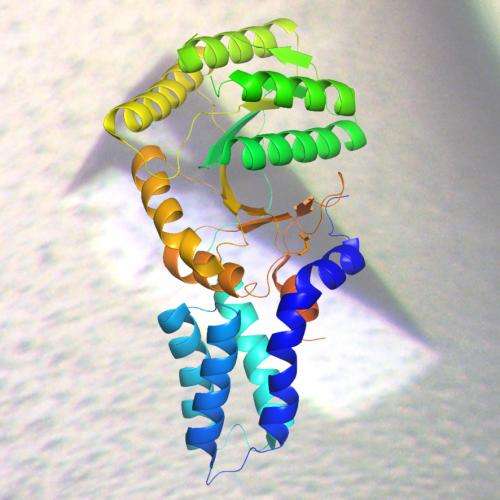How the protein transport machinery in the chloroplasts of higher plants developed

A research team has studied how the protein transport system of bacteria developed over time to form the system in the chloroplasts of higher plants. They explored the so-called signal recognition particles and their receptors. Bioinformatic and biochemical analysis revealed that the moss Physcomitrella patens has evolutionarily old and new components of the SRP system, and thus represents an intermediate stage in the development from the bacterial transport system to the chloroplast system in higher plants.
Together with colleagues from Sweden, RUB researchers have studied how the protein transport system of bacteria developed over time to form the system in the chloroplasts of higher plants. They explored the so-called signal recognition particles (SRP) and their receptors. Bioinformatic and biochemical analyses revealed that the moss Physcomitrella patens has evolutionarily old and new components of the SRP system, and thus represents an intermediate stage in the development from the bacterial transport system to the chloroplast system in higher plants. The international team led by Prof. Dr. Danja Schünemann and Dr. Chantal Träger from the Working Group Molecular Biology of Plant Organelles at the Ruhr-Universität reported in the journal The Plant Cell.
In the cell fluid, a special transport machinery conveys proteins from their origin to their place of work, for example in the cell membrane. The decisive factor is the so-called SRP system. It binds itself to the protein to be transported, travels with it to the cell membrane and interacts there with the SRP receptor (FtsY). If the SRP system binds to the receptor, cleavage of the energy storage molecule GTP triggers further processes which ultimately anchor the protein in the membrane.
In the cell fluid of bacteria, animals and plants, the SRP system consists of two components: the protein SRP54 and the ribonucleic acid SRP RNA. Several years ago, researchers found that the chloroplasts of higher plants, i.e. the photosynthetically active cell components, possess their own SRP system. It is very different from the system of the cell fluid because it has no SRP RNA. However, alongside SRP54 it also contains the protein SRP43, which occurs exclusively in chloroplasts. Scientists assume that chloroplasts originated from cyanobacteria, which initially lived in symbiosis with plant progenitor cells and were ultimately integrated into the plant cells. The scientists have now explored how the RNA-free SRP system of the chloroplasts originated from the RNA-containing SRP system of the bacteria.
With the aid of bioinformatics, the Bochum biologists and Dr. Magnus Rosenblad of Gothenburg University first examined which representatives in the plant kingdom have which components of the SRP system in their chloroplasts. "We were surprised that many organisms from unicellular green algae to mosses and ferns possess the gene for the SRP RNA in their chloroplasts", says Danja Schünemann. "The only exceptions are the higher plants, which have lost this gene". For them, the SRP system consists solely of the proteins SRP54 and SRP43. Interestingly though, SRP43 also occurs in the chloroplasts of lower plants, which are still equipped with SRP RNA.
In collaboration with several groups of the Collaborative Research Centre SFB 642 at the RUB, Dr. Chantal Träger investigated the biochemistry of the moss Physcomitrella patens, which is among the lower plants. Physcomitrella has all the conceivable components of the SRP system in its chloroplasts: both the evolutionarily old components SRP54 and SRP RNA, as well as the more recent evolutionary protein SRP43. However, the SRP RNA of the moss chloroplasts forms a longer loop than the bacterial SRP RNA. This altered structure apparently prevents it from regulating the cleavage of GTP. Physcomitrella patens thus contains the evolutionarily old SRP RNA, which has largely lost certain functions. The SRP system of the chloroplasts of Physcomitrella patens therefore represents the transition between bacteria and higher plants. An X-ray structure analysis also revealed that the SRP receptor (FtsY) of the moss already has properties of the protein of higher plants.
More information: C. Träger, M.A. Rosenblad, D. Ziehe, C. Garcia-Petit, L. Schrader, K. Kock, C.V. Richter, B. Klinkert , F. Narberhaus, C. Herrmann, E. Hofmann, H. Aronsson, D. Schünemann (2012): Evolution from the prokaryotic to the higher plant chloroplast Signal Recognition Particle: the Signal Recognition Particle RNA is conserved in plastids of a wide range of photosynthetic organisms, The Plant Cell, DOI: 10.1105/tpc.112.102996
Journal information: Plant Cell
Provided by Ruhr-Universitaet-Bochum


















